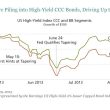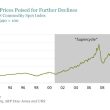"The Suit?"
by Jeffrey Saut, Chief Investment Strategist, Raymond James
September 9, 2013
... he was a first-class salesman and was earning his living in the suit-length trade.
Basic needs for entry into ‘suit lengths,’ are courage, and a couple of three-and-a-half-yard pieces of suitable material. Here’s how the business works:
The salesman selects an apartment building in the middle-class section of any city. He rings a doorbell. ‘Is Mr. Dupont (or Anderson or Schmidt) at home?’ The occupant, who bears none of these names, is constrained to reply that he has never heard of the gentleman requested. ‘This is the address I was given.’ The salesman continues, ‘and it’s kind of important that I find him, since I have a package for him and I’m about to leave town.’ He then explains that he is a steward on a ship, or for an airline, and just in from London or Beirut, ‘where the best English materials for men’s suits cost less than half of what they do here.’ ‘I’m really kind of irritated,’ the salesman goes on. ‘I picked these two suit lengths up as a favor to Mr. Dupont, and now I’m leaving town again and I’m going to be stuck with them. I should learn to stop doing favors for people.’
Then the light of an idea flickers in his eye. ‘Hey, maybe you would like to take a look ... ’? Once the sale to the surrogate Dupont is closed, it’s down to the local remnant store for more stock (read: suit lengths) and back to another doorbell. For the customer, the charm of buying material for a suit in this way lies in the sneaking suspicion that he is getting a real bargain and engaging in a mild form of law-breaking, which really hurts no one. For the salesman, it’s a way to add romance to the otherwise dull dry-goods business. [Thus,] it was marvelously easy to learn the mutual fund presentation, as written by Bernie Cornfeld, and go out selling freedom from financial worry at bargain rates instead of the latest cheviots and tweeds.
The Bernie Cornfeld Story, by Bert Cantor
Bernie Cornfeld, of IOS Fund fame (http://en.wikipedia.org/wiki/Investors_Overseas_Service), coined the phrase, “Do you really want to be rich?” Bernard “Bernie” Cornfeld (1927 – 1995) was a prominent international financier that sold mutual funds, in a “confidence game” influenced manner, who was tried and acquitted for those sales tactics. Still, his antics in the late 1960s cost investors millions as the secular bull market of 1949 to 1973 ended, leading to massive losses into the December 1974 low. At the time I was working as a stock broker, and writing investment strategy for E.F.Hutton, having penned in December 1974 that, “I recommend a gradual return to significant common stock accumulation” (I still have that report). I also learned that you have to evaluate the risks, because sometimes when you go after the “big bucks” you lose. Then you end up with small change! In essence, you must basically determine the risks versus your years of life potentially left to accumulate wealth.
Indeed, being a young man, I decided to go for the “big bucks” and literally went to Wall Street in 1971 to begin working on a trade desk for the sum of $100 a week (not exactly big bucks). Once there, I read Bert Cantor’s book The Bernie Cornfeld Story and asked myself the question, “Do you really, sincerely, want to be rich? Do you have the mental fortitude to accept huge stock market gains?” The book explained that if you do, you have to redefine your normal range of profit such that when the big trade comes along, you must possess the self-esteem to take all that is offered. You have to do that because you’re in the position to pay yourself back for all the work, risk, fear, sweat, and frustration over the years. You sincerely deserve to be rich!
If you don’t want to be like other investors, because a lot of them end-up with small unrewarding investments, a thousand here and there, then they wake up with grey hair and a few hundred thousand dollars. That’s all they have. So taking a stock position, like I made early in my career, going on margin, borrowing money to buy more as that stock declined, then having it start to move “up” into a large profit, is a better education than any MBA. As Jim Rogers states, “You can learn more from trading one pork belly future than from any university.” Now I would like to tell you that story had a happy ending, but I took said position at the top of the early 1970s bull market. Regrettably, along came the bone-crunching 1973-74 bear market, busting Bernie Cornfeld’s IOS mutual fund, while cutting the D-J Industrial Average in half. What happened? I learned the most important rule of investing, manage the downside risk. I began this commentary with a suit story, so I will give you another:
A man was traveling abroad when he received a call from his sister informing him that their father had died unexpectedly. It was physically impossible for the brother to get back home to the funeral, so he told his sister to take care of the funeral arrangements and to send him the bill. After returning home he received a bill for several thousand dollars, which he promptly paid. The following month another bill came along for $15, and he paid that too. Another month followed, with a similar bill. When, in the next month, a third bill for $15 was presented, he called his sister to ask what was going on. ‘Oh,’ she said, ‘I forgot to tell you, we buried Dad in a rented suit’!
That current “rented suit” is the massive debt our government has accrued and in a rising interest rate environment that “rent” is coming due. As my friends at the astute GaveKal organization, whose mutual funds I own and recommend (GAVAX/$13.04), opine:
A worry is that the rise in yields is starting to become more of a hurdle for equity markets. Indeed, when real yields were in negative territory, forward-thinking investors had little choice but to move up the risk curve towards equity markets. However, the fact bonds are rapidly approaching ‘fair value’ means equities will now start to suffer from asset class competition. Some 18 months ago, OECD equities were very attractively valued, and bonds [were] grossly overvalued. Today, both appear roughly fairly valued, implying that the rotation from one asset class to the next is no longer a ‘slam-dunk.’ If bonds continue to sell-off from here, then the relative valuation game will ‘tilt’.
Quite frankly, I have thought the bond carpet-bombing was overdone in the near term, but that the bond secular “bull market” ended in July 2012. Accordingly, I have no interest in bond funds other than Putnam’s Diversified Income Trust (PDINX/$7.88). That near-term overdone feeling was reinforced last Friday in what looked like a downside reversal in the 10-year Treasury note’s yield (read: lower rates). The reversal was sparked by Friday’s weaker than expected employment report leaving investors thinking no “tapering” this month. That caused the “suit length” salesmen to show up early on the Street of Dreams in an attempt to put “lipstick on this pig,” producing an initial 12-point pop in the S&P 500 (SPX/1655.17). However, reality quickly returned leaving the SPX down about 13 points by 10:00 a.m. From there another rally attempt was made, which failed, as the SPX closed around the flat-line. The recent action has left stocks neither overbought nor oversold. Likewise, the Demand and Supply indicators are neutral, although the rally attempts have been more about a lack of sellers rather than erstwhile buyers. So I enter this week still believing the pullback is not complete. The SPX fell by 4.8% from its August 2nd intraday high into its August 28th intraday low. Since then, it has rallied 2.3% into last Friday’s intraday high. If my methodology of interpreting the equity markets continues to work, another decline should begin this week, and eventually that decline should be bought. So get your shopping lists ready.
The call for this week: Speaking of getting your “shopping list ready,” I am hosting another conference call like the one two weeks ago with my friend Tom O’Halloran, who gave us a bunch of interesting stock ideas that he owns in his fund, the Lord Abbett Growth Leaders Fund (LGLAX/$20.13). Tomorrow afternoon I am hosting a call with another friend, and great stock picker, Mary Lisanti, who captains The Adams Harkness Small Cap Growth Fund (ASCGX/$18.33). Like Tom’s fund, I also own Mary’s fund. What should be interesting about tomorrow’s call is that Mary will not only discuss her investment style, but also speak to individual stocks she owns that are followed by Raymond James’ research department. The time is 4:15 p.m., Tuesday 9/10/13. The call number is (866) 393-7146 with no passcode required. For international callers, the number is (518) 444-5129 with the passcode 40297133.














